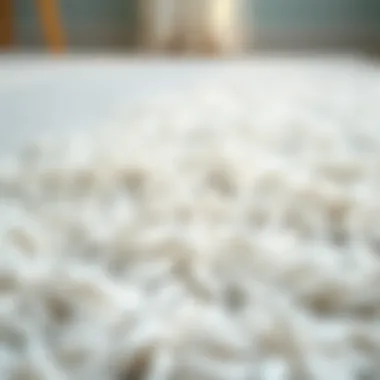Exploring the Beauty and Functionality of White Area Rugs


Intro
When stepping into a room adorned with clean white area rugs, it's hard not to feel a wave of calm wash over you. These pieces are more than just floor coverings; they embody a delicate interplay of aesthetics and functionality, striking a chord with home decorators and architecture lovers alike. In a world where first impressions matter, the choice of a white area rug can change not only the visual landscape of a space but also its overall ambiance.
Imagine a sleek modern living room where the stark white rug sets off dark furniture, creating a striking contrast that draws the eye. Or picture a cozy study with soft light streaming in, where a plush white rug invites you to kick off your shoes and sink into a good book. Yes, these rugs hold potential far beyond mere decoration.
In this article, we will navigate through the multifaceted role of white area rugs within contemporary interior design. We'll delve into notable architectural styles, unique design elements, and crucial maintenance tips. This guide aims to equip those in the real estate field, travel enthusiasts, or interior design aficionados with valuable insights on the balance of beauty and practicality that white area rugs can offer in various settings.
If you’ve ever considered adding one of these rugs to your living space, stay tuned. We’ll explore how to choose the right style, the art of positioning, and the best care techniques to keep your rug looking fresh long after its initial introduction.
Preamble to Clean White Area Rugs
Clean white area rugs have a striking presence in modern interior design, often seen as the perfect foundation that can either enhance or define a space. They stand out for several reasons; first, their ability to evoke a sense of calm and simplicity that resonates well within various design contexts. The crispness of white, paired with its versatility, turns a mere floor covering into an impactful element of decor.
Significance in Modern Interior Design
In today’s world, where minimalism and functionality reign supreme, clean white area rugs have carved a niche for themselves. They serve as a blank canvas, allowing homeowners to mix colors, patterns, and textures without feeling overwhelmed. This quality makes them particularly significant for those who enjoy frequently updating their decor without the expense of buying new furniture or artwork.
The predominance of open-space layouts in contemporary homes means that the choices we make in flooring become even more crucial. A white rug can act like a visual separator, defining areas within a larger space without adding clutter. This ability to delineate rooms while adding a touch of elegance often gives them a stature that more vibrant colors can struggle to achieve.
Moreover, clean white area rugs often serve as the unsung heroes of comfort and coziness. They invite people to sit down, lounge, or gather, promoting a sense of warmth that is often lost in rigidly designed spaces.
Evolution of Rug Usage
Rugs have been around for centuries, initially serving as practical tools for insulation and comfort. However, the role of rugs has dramatically evolved over time. With the advent of modern interior design, clean white area rugs have transitioned from being mere functional items to becoming statements of style and sophistication.
In ancient times, rugs were often made from natural fibers and designed for specific uses. As styles shifted, just like many trends, white rugs were seen in more historical contexts as symbols of purity and status.
Today, rugs are crafted from a wider array of materials, and the perception of clean white areas has shifted as well. No longer are they considered too delicate for everyday use; advancements in production have led to options that are durable and easy to maintain.
For instance, synthetic fibers are often used to replicate the look of traditional materials while offering stain resistance and easier cleaning solutions. This shift signals a greater acceptance of white area rugs in spaces that are frequently used, such as living rooms and family areas, thus underscoring their evolving purpose in modern design.
"White area rugs are no longer just part of a decor; they embody the ease of living while enhancing the aesthetics of a home."
In summary, the journey of clean white area rugs in home design illustrates their transformation from practical floor coverings to essential accents that marry functionality with beauty, allowing them to remain relevant in our ever-changing interiors.
Design Aesthetics of Clean White Area Rugs
When pondering the role of clean white area rugs within a space, their design aesthetics are pivotal. These rugs not only elevate the visual appeal of an environment, but they also serve as a canvas that reflects personal style. A clean white rug can ground a room while also infusing it with a sense of calm and elegance.
Design aesthetics of these rugs span various styles, and understanding their attributes can significantly enhance one's decor goals. Many homeowners find themselves drawn to white rugs for their ability to adapt, allowing flexibility in design choices. When a simple white rug is placed strategically, it can highlight artwork, furniture, or other decorative elements. This versatility is essential in contemporary interior design, as it can shift the focus in a room without overwhelming it.
Complementing Various Design Styles
Minimalism
Within minimalist design, every element counts. Clean white area rugs naturally align with this approach due to their ability to enhance a space without adding visual clutter. Their key characteristic lies in their simplicity, which fosters an atmosphere of serenity and order. In minimalism, less is often more, making white rugs a beneficial choice since they allow other elements in the room to shine. However, they can also present challenges, as stains are more visible than on darker rugs, demanding a certain level of upkeep to maintain their pristine look.
Bohemian
The Bohemian style thrives on the eclectic mix of colors, patterns, and textures. A clean white rug can introduce a subtle contrast, softening the vibrant chaos typical of this aesthetic. Its unique feature is its ability to act as a neutral base while still maintaining a cozy, lived-in feel. While a Bohemian setting can become overwhelming with color, incorporating a white rug allows for a grounding element, making this combination popular. That said, the challenge lies in ensuring it harmonizes with the multitude of other colors and patterns to avoid looking stark.
Scandinavian
Scandinavian design is known for its functional beauty, emphasizing simplicity and warmth through natural materials. White rugs fit neatly into this philosophy, reinforcing the aesthetic of bright, airy spaces. Their key characteristic is promoting light, which is crucial in often dim climates. This makes them a favored choice among designers. Furthermore, the understated elegance of a clean white rug can complement the organic textures typical of Scandinavian decor, yet it requires careful selection to ensure it aligns with the overall warm color palette.
Textural Considerations
Wool
Wool is renowned for its resilience and luxurious feel, making it a popular choice for white rugs. Its inherent durability contributes to both the aesthetic and practical aspects discussed earlier. Wool rugs can not only withstand the rigors of everyday life but also provide warmth and comfort underfoot. One unique feature of wool is its natural stain resistance, which can mitigate concerns about maintenance often associated with white textiles. Yet, they can be on the pricier side, which might deter some.
Cotton
Cotton rugs are celebrated for their versatility and affordability. Their ease of cleaning makes them particularly appealing for households with pets or children. Clean white cotton area rugs can bring a fresh, casual vibe to any room. Their key characteristic is the breathable, soft texture they provide, which can create a relaxed atmosphere. However, it's essential to note that cotton may not be as durable as wool, and regular washing may be necessary to keep the rug looking its best.


Synthetic Fibers
Synthetic fibers, like polypropylene or nylon, have surged in popularity due to their durability and resistance to stains. These rugs can often mimic the appearance of natural textiles, offering a clean white alternative without the upkeep associated with wool or cotton. What makes synthetic options stand out is their unique feature of weather resistance, perfect for high-traffic areas or outdoor settings. Still, the trade-off is often a less authentic feel compared to natural fibers.
Practical Benefits of Clean White Area Rugs
Clean white area rugs are not just about aesthetic enhancement; they offer a plethora of practical benefits that can elevate a space significantly. From creating an atmosphere of openness to improving acoustics, the advantages are manifold. Below we will explore how these rugs can play a crucial role in everyday living while also considering the variety of domestic environments they inhabit.
Enhancing Light and Space
When it comes to the illusion of space and light, clean white area rugs work wonders. They reflect natural light, making interiors feel more airy and open. Think about those rooms with less natural sunlight, maybe a cozy den or a compact apartment; these spaces can feel cramped. A bright rug can transform the very essence of such a room. The clean white shade can help visually enlarge a locale, helping houses feel less cluttered and more welcoming.
Another interesting aspect is that they can unify a layout. In an open-concept space, a white area rug can create a focal point, delineating different areas without the need for physical barriers. Placing a rug beneath a coffee table, for instance, can anchor a sitting area, making it feel like a complete thought. This harmony created by the combination of items placed on a white rug—like colorful throw pillows or a stylish coffee table—contributes not only to beauty but also to a lived-in, friendly atmosphere.
- Brighter Ambiance: White reflects light rather than absorbing it, resulting in a brighter place.
- Sense of Space: It opens up the room visually, making even a smaller area feel more expansive.
- Anchor Point: Acts as a central piece in open layouts, designating spaces without physical walls.
Sound Absorption Properties
Often overlooked, the acoustic qualities of clean white area rugs merit attention too. These rugs can serve a critical role in dampening volumes within a room. The soft fibers absorb sound waves, decreasing that echoey feeling that sometimes comes with tile or hardwood floors. This is particularly vital in homes with children or pets, where noise can quickly escalate.
In open spaces filled with hard surfaces, the simple addition of a clean white rug can transform the sound dynamics, making conversations more pleasant and intimate. Think of how it feels when you walk into a room that’s too loud—it's uncomfortable. Now, imagine the opposite: When the floor is softened by plush fabric, even a boisterous gathering feels more controlled and inviting.
Benefits include:
- Noise Reduction: Soft fibers help absorb sound, promoting a quieter environment.
- Comfort: Walking on soft rugs is easier for feet compared to hard surfaces, creating a more enjoyable atmosphere.
- Reduced Echo: Damps acoustic echoes that can result in overwhelming sound in larger spaces.
In sum, clean white area rugs do not just beautify your home; they serve essential practical functions that enhance comfort and usability.
These practical benefits position clean white area rugs as more than mere decoration. They balance functionality with style, making them not just an option but an essential component of thoughtful interior design.
Choosing the Right Clean White Area Rug
Selecting the perfect clean white area rug is no small task. It’s like picking the right cherry from a tree; you want one that not only looks good but also fits into your overall aesthetic. Among the myriad of options available, a rug can act as the backbone of a space, tying together all the elements to create a harmonious environment. A thoughtfully chosen rug serves as both a statement piece and a functional element, enhancing the visual appeal of your home while also providing comfort and warmth.
Size and Placement Considerations
When it comes to rugs, size truly does matter. An area rug that’s too small can look like it was an afterthought, while one that’s too large can overwhelm a space. You want your rug to create a sense of balance and flow. Generally, a good rule of thumb is to ensure that at least the front legs of your furniture are sitting on the rug. This helps to delineate the area while also providing a cozy feel.
- Living Room: A large rug can anchor a seating area, creating a welcoming space for conversation. Here, a 9x12 or greater often works wonders, covering enough ground to make guests feel "set" in one area.
- Bedroom: For bedrooms, a rug under the bed creates softness underfoot. A runner at the sides can offer warmth when you first step out in the morning.
- Dining Room: In dining areas, the rug should extend beyond the edges of the table. This allows for easy movement of chairs without snagging on edges.
Consider the layout of the room before making a selection. You don’t want your rug to clash with the flooring or any other design elements; rather, it should complement them. Additionally, think about the traffic in the area - high-traffic zones might necessitate a rug that’s durable yet still maintains the elegance of white.
Material Selection
Selecting the right material for your white area rug is crucial—not just for aesthetics, but for practicality too. By choosing wisely, you can ensure it withstands time and daily wear.
- Wool: Renowned for its durability and natural resilience, wool is an excellent choice if you want a rug that looks plush and stands the test of time. It’s also resistant to dirt, making it easier to maintain a clean appearance.
- Cotton: If you’re after something soft and lightweight, cotton might just fit the bill. It’s highly absorbent, but be mindful that it can stain easily. For an occasional wash, cotton rugs shine, retaining their charm with each clean.
- Synthetic Fibers: Options like polypropylene or nylon might not hold the prestigious appeal of natural fibers, but they often offer superior stain resistance and easy care. They are worth considering if you have pets or children.
Key Takeaway
Remember, a rug should echo the overall vibe of your space. In essence, choosing the right rug is a balance between what looks good and what serves your needs. Don’t be afraid to think outside the box; sometimes the most unexpected choices yield the best results.
"A rug is not just a piece of decor; it's the foundation of a room, setting the tone for everything else around it."
For more detailed insights, you might find resources from Britannica helpful. With the concepts of design in mind, do your due diligence as you turn your focus on the clean white area rug that best meets your home's identity.
Care and Maintenance of White Area Rugs
Keeping white area rugs in tip-top shape goes beyond just a surface level clean. It’s crucial for enhancing not only their aesthetic appeal but also their durability. Considering the investment in these elegant pieces, understanding the ropes of maintenance can save you time and money down the line. A clean, well-kept rug elevates the ambiance of your space and ensures that it continues to complement your home’s design.
Cleaning Techniques for Longevity
When it comes to cleaning, two techniques stand out: spot cleaning and deep cleaning. Each has its place and knowing when to use which can make all the difference.
Spot Cleaning


Spot cleaning is essential for tackling those inevitable stains that occur in everyday life. Spills happen, pets leave their mark, and sometimes, dirt just finds its way onto your pristine white rug. The key characteristic of spot cleaning is its ability to act fast. Addressing stains before they set means you're likely to avoid permanent damage, which is vital for maintaining the rug's look.
The unique aspect of spot cleaning is that it allows for selective treatment. Instead of overwhelming the entire rug with water and cleaning solutions, which could jeopardize its integrity or leave unsightly marks, you focus only on the affected area. This means that you could use a fabric cleaner or a mix of mild detergent and water, applying it gently with a clean cloth. You’d be surprised how effective gently blotting a stain can be. On the downside, if not done correctly, spot cleaning might leave a residue or water marks if the area isn't dried thoroughly.
Deep Cleaning
Deep cleaning is the heavy hitter in your rug maintenance arsenal. Unlike spot cleaning, this method takes a broader approach, addressing the entire rug's surface. It dives deeper into the fibers, removing dirt and allergens that accumulate over time. Typically, this involves either professional cleaning services or using specialized equipment like steam cleaners.
The nature of deep cleaning is thoroughness. It’s designed to refresh not just the appearance but also the overall hygiene of the rug. While this method is beneficial for those who experience allergies, it does have its constraints. Regular deep cleaning can wear down certain types of fibers and may affect the rug’s color if the wrong cleaning agents are used. Finding a balanced schedule for deep cleaning is key to keeping your rug in top shape.
Preventive Measures
Preventive measures can help keep your white rugs looking pristine longer. Here are some techniques to enhance the lifespan of your rugs:
- Regular Vacuuming: Frequent vacuuming helps remove dust before it settles into the fibers. Aim for at least once a week, perhaps more often in high-traffic areas.
- Rug Pads: Using a quality rug pad can protect the underside of your rug and provide added cushioning. It reduces slipping and also absorbs some of the wear from foot traffic.
- Rotating Your Rug: If positioned in a spot that receives direct sunlight, rotating it every few months helps prevent fading and uneven wear.
- Avoiding Heavy Furniture: Whenever possible, avoid placing heavy furniture directly on the rug. Instead, you can use lighter accessories or area weights to protect it from indentations.
By implementing these care and maintenance tips, you will maximize the beauty and longevity of your clean white area rug, ensuring it remains a stunning focal point within your home.
Common Misconceptions About White Area Rugs
When it comes to clean white area rugs, many people have misgivings that stem from long-held beliefs about color, maintenance, and their aesthetic versatility. This section aims to debunk those myths and underscore the real value of incorporating white rugs into your home decor. Understanding these misconceptions is crucial for anyone looking to elevate their space with the right choices, especially in a world where the aesthetic appeal and practicality often find themselves at odds.
Perceived Difficulty in Maintenance
One of the foremost misconceptions about white area rugs is the notion that they demand Herculean efforts to keep them looking pristine. Sure, it's true that white can be more revealing when it comes to stains and dirt, but that doesn't mean painstaking care is the only option. In fact, many contemporary rugs are designed with durability and easy maintenance in mind. Some materials, like synthetic fibers or treated cotton, resist stains better than you might think.
For example, a well-chosen polypropylene rug not only boasts a chic appearance but can withstand spills and foot traffic far more effectively than its natural counterparts. Brushes and vacuums typically suffice for regular upkeep, while many white rugs are also machine washable, offering an easy route to freshening them up. It's a matter of selecting the right type, rather than shying away from white altogether.
"A white rug can be a canvas for your creativity, it just takes a little thought in your material choice."
Assumptions About Decor Limitations
Another common belief is that white area rugs limit one's decor options. On the contrary, clean white rugs have the remarkable capability to serve as a versatile backdrop for various styles and themes. They can seamlessly integrate into eclectic, minimalist, or even vibrant, bohemian spaces.
Consider a few noteworthy points regarding this misconception:
- Neutral Palette: A white rug creates a blank slate, allowing other decor elements to shine without competing.
- Color Pop: It can highlight colorful furniture and accessories, turning a subdued room into a vibrant masterpiece.
- Layering: White rugs work fabulously with other textured or colorful rugs — try layering a white shear rug over a patterned rug to add depth and warmth.
This versatility debunks the myth that white area rugs can’t hold their own within a diverse palette. Instead, they can become the glue that binds various design elements together, encouraging creativity rather than deadening it.
With these facts in tow, one can appreciate that a clean white area rug is not merely a practical choice, but also a strategic one that encourages a broader design vision and a more sustainable approach to home decor.
Incorporating White Rugs in Varied Spaces
Incorporating clean white area rugs into various spaces of a home is more than just a matter of aesthetics; it is about creating a harmonious environment that speaks to both style and utility. When thoughtfully placed, these rugs can transform ordinary rooms into extraordinary havens. However, to achieve this transformation, one must consider specific elements such as the room's function, decor style, and how the rug interacts with other elements in the space.
White area rugs can serve as a canvas upon which the personality of a room is painted. They provide a neutral backdrop while allowing other colors and textures to shine.
Living Rooms and Common Areas
Living rooms are often the heart of a home, a place where families gather and guests are entertained. Here, a white area rug can enhance the feeling of openness and light. It visually expands the space and can be used strategically to define different areas, like a seating area or a reading nook.
- Color Coordination: Since white can be a blank slate, it allows for flexibility in color schemes. Accent pillows or throws can easily be switched out to update the look of the space, keeping the room fresh and inviting.
- Textural Contrast: Combining different textures, like a plush white shag rug with a sleek leather sofa, can create visual interest and comfort. People tend to appreciate the tactile contrast, making the living area feel warm and welcoming.
Bedroom and Relaxation Zones
In bedrooms, clean white area rugs can contribute significantly to a serene atmosphere conducive to relaxation. They can act almost like a warm embrace as one gets out of bed, minimizing the chill of cold floors.
- Layering: Layering a white rug over a hardwood floor or existing layered textiles softens the room, adding a cozy dimension. This can be particularly effective in creating a luxurious ambiance.
- Minimalist Approach: For a minimalist design, a simple white rug under the bed can create a striking effect, drawing attention to the bed's frame and enhancing the overall simplicity of the design. Less truly can be more in a calming retreat.
Entryways and Hallways
Entryways and hallways set the tone for the rest of the home. A clean white rug here not only adds aesthetic value but also provides a functional aspect by capturing dirt and debris.
- First Impressions Matter: A well-placed white rug can leave a lasting first impression, inviting guests into a home with grace. Choosing a rug that can withstand the foot traffic yet still maintains its pristine look is crucial in these transitional areas.
- Narrows and Expands: In narrow hallways, a white rug can make the space feel wider. By guiding the eye down the corridor, it can lead guests to the heart of the home while keeping the environment looking chic and crisp.


In summary, incorporating clean white rugs into varied living spaces creates a balance of beauty and practicality. By addressing specific considerations in each room type, one can fully leverage the unique advantages of a white rug while maintaining an elegant aesthetic. This thoughtful approach ensures that these rugs serve their purpose beyond mere decoration.
White Area Rugs in Cultural Context
Clean white area rugs aren’t merely a design element, they also hold significant cultural relevance that transcends mere aesthetics. In various societies, the color white is often associated with purity, cleanliness, and new beginnings. This section dives deep into the symbolic undertones of white area rugs across different cultures, alongside historical perspectives that enrich our understanding of their texture and color.
Symbolism Across Different Cultures
In many cultures, white symbolizes purity and simplicity. For instance, in traditional Western weddings, brides don white gowns, signifying purity and a new beginning. This symbolism can be mirrored in white rugs within a home, reflecting ideals of cleanliness and serenity. In Eastern cultures, particularly in countries like Japan, white represents a clean slate, a new start. The Japanese often use tatami mats in various shades of white or light colors, emphasizing minimalism and tranquility. To them, maintaining clean white rugs can be a form of meditation, a connection between the living space and the natural world.
Interestingly, certain cultures view white differently. In some African traditions, white is worn during mourning. This duality showcases how white area rugs can evoke differing emotional responses depending on the cultural lens.
- Purity and cleanliness: Common in Western traditions
- New beginnings: Seen in various Eastern beliefs
- Cultural duality: Represents joy in some traditions and sorrow in others
This spectrum of meanings serves to heighten the appreciation of clean white rugs far beyond their physical attributes, inviting one to reflect on the personal and cultural narratives they embody.
Historical Perspectives on Color and Texture
Throughout history, colors have carried profound meanings, shaped by societal values and technological advancements in dyeing techniques. In ancient civilizations, white was often reserved for the elite. For instance, in Ancient Rome, only the wealthy could afford to keep garments and fabrics as bright white, thanks to labor-intensive cleaning processes. The advent of synthetic dyes, however, made white more accessible later on, democratizing its use in households and redefining contemporary perspectives.
Texture also plays a crucial role in the historical narrative of area rugs. The softness of materials like wool and cotton available in white not only provides comfort but also mirrors societal preferences for opulence and elegance. Throughout different eras, from the opulent palaces of the Middle Ages to the minimalist designs of the modern era, the texture has shifted dramatically, but white remains a constant favorite in high-design contexts.
- Color significance: White as a mark of wealth in antiquity
- Material evolution: Transition from natural fibers to modern synthetics
- Cultural shifts: How social movements have influenced the prevalence of white rug use
The historical context adds layers of richness to the understanding of clean white area rugs, illustrating not just their utility in design but their heritage and the stories they carry through time. Thus, these rugs are not only decor but also artifacts laden with the weight of cultural narratives and historical evolution.
Sustainability and Ethics in Rug Production
The conversation surrounding interior design is not limited to aesthetics and functionality alone; sustainability and ethics in production are becoming mainstream considerations that resonate with discerning homeowners and designers alike. When it comes to clean white area rugs, these topics are vastly important. Choosing a rug involves evaluating how materials are sourced, what it entails for the environment, and understanding how ethical considerations impact the entire production process.
Rugs may seem like benign items, but their production often comes with significant environmental consequences. From raw material extraction to manufacturing processes, the journey of a rug can be fraught with ecological footprints that can take years, even decades, to mitigate. For that reason, folks are increasingly holding brands accountable. They demand transparency in how their favorite rugs are made. The gravity of this demand cannot be overstated and it intertwines nicely with how aesthetics can coexist with environmental consciousness.
"Purchasing a home accessory isn’t just a superficial act. Each choice echoes a larger narrative about sustainability."
Material Sourcing Challenges
The first puzzle in the framework of sustainability is how materials are sourced. Whether using natural fibers like wool and cotton or synthetic ones like polyester and nylon, the environmental costs can vary widely. Natural fibers can be biodegradable and often have a lower carbon footprint compared to their synthetic counterparts, but they come with challenges too.
For example, wool is often touted for its durability and comfort, yet many people overlook the environmental strains associated with sheep farming, such as land degradation and high water usage. Furthermore, harvesting cotton has its own set of dilemmas, primarily involving pesticide use and water consumption.
Conversely, synthetic rugs, while often less energy-intensive to produce, can contribute to plastic pollution and take centuries to decompose. This makes it a tug-of-war between sustainability and practicality. Homeowners need to be aware of these intricacies when deciding which rug to go for.
Eco-Friendly Alternatives
Fortunately, the market is evolving to meet these pressing concerns. The rise of eco-friendly alternatives is an encouraging trend. Using recycled materials is becoming more common, with manufacturers creatively utilizing discarded plastics and fabrics to craft new rugs. These alternatives not only reduce waste but also diminish the demand for new raw materials, thus easing the strain on Mother Earth.
Additionally, organic fibers have made a splash in contemporary rug-making. With certifications that ensure sustainable practices, consumers can purchase rugs made from organically grown cotton or bamboo without contributing to harmful cultivation practices. These options tend to embellish homes with a chic aesthetic while ticking the sustainability box.
In summary, the challenges in material sourcing and the availability of eco-friendly alternatives present a dynamic landscape for homeowners and designers inspired by ethics in rug production. As this trend continues to unfold, it highlights a growing alignment between aesthetic choices and responsible consumerism, making clean white area rugs a remarkable accent to modern home decor.
Epilogue: The Lasting Impact of Clean White Area Rugs
When assessing the role of clean white area rugs in interior design, it’s crucial to recognize their enduring influence, not just on aesthetics but also on overall functionality within a space. These rugs serve as a canvas that highlights other elements of the room while contributing to a sense of coherence and tranquility. Their ability to blend seamlessly with a variety of styles makes them more than mere furnishings; they are pivotal in shaping the atmosphere of contemporary living.
Final Thoughts on Aesthetic Value
The aesthetic value of clean white area rugs cannot be overstated. These pieces hold a unique power to transform a space, offering a fresh, airy feel that can amplify light and create a sense of openness. Think of it this way: a well-placed white rug does wonders for a room that might otherwise feel cramped or cluttered. It's like a breath of fresh air, bringing clarity to environments saturated with color and decor.
Moreover, the neutral palette of white allows homeowners to embrace various accents and textures within their interiors. A white rug acts as a balancing force amidst bold colors or intricate patterns. Its ability to be a chameleon, adapting and harmonizing with a plethora of styles—from the serene lines of Scandinavian design to the layered chaos of Bohemian setups—highlights its versatility.
Another noteworthy aspect is how a clean white rug can evoke feelings of comfort and cleanliness. It's an antidote to the fast-paced world outside. The sight of a plush white area rug can encourage relaxation and mindfulness at home. In short, the aesthetic contribution of these rugs is multifaceted—it enchants the eye while serving a multitude of practical roles.
The Role in Future Design Trends
As we look ahead to future trends in interior design, it becomes evident that clean white area rugs are poised to maintain their relevance. With a growing demand for innovative sustainability practices, many consumers are leaning towards natural materials that blend aesthetic appeal with accountability to the environment. Rugs made from organic cotton or sustainably sourced wool align perfectly with this ethos.
In addition, minimalism continues to make waves in modern design. The timeless quality of white area rugs signifies simplicity and elegance, perfectly suiting the minimalist agenda that values fewer but more meaningful possessions. As people seek to declutter their lives, rugs that prioritize clean lines and refined aesthetics are sure to be in demand.
Moreover, the trend towards multifunctional spaces raises the stakes for adaptable decor. Rugs, especially those in light colors, can provide the necessary flexibility to redefine a space based on needs or moods. The absence of strict boundaries in design signifies an evolution toward cohesive, multifunctional living, which clean white area rugs can help facilitate.
"A white rug doesn’t just cover the floor; it invites possibilities. It allows the imagination to soar while offering solace and sophistication, transforming the ordinary into extraordinary."
In summary, the journey of clean white area rugs in home decor is filled with depth. Their influence runs deeper than mere aesthetics, encompassing emotional resonance and forward-thinking design. Whether established in the current design embrace or guiding the direction of what lies ahead, they will surely always hold a place of significance in the hearts of design aficionados.















